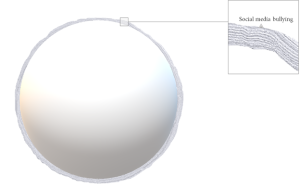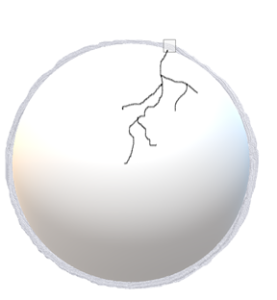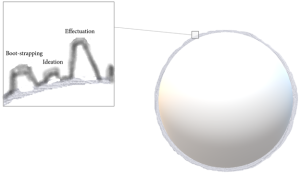2 The purpose of a literature review
Simply put, the purpose of a literature review is to recognize and track the previous knowledge upon which research is built. In the thousands of years that humans have been observing their surroundings and making discoveries, we have collectively built a sizeable body of knowledge. Homo erectus (purportedly) created the first controlled fire. Likely this happened by observing the aftermaths of lightning strikes, and then discovering the result of friction between organic matter, or experimenting with colliding various rocks together. They certainly did not have the organized process we have today for expanding the body of knowledge, but they made a momentous contribution no less – controlled fire allowed for a considerable list of other possibilities within civilization (forging weapons, cooking, etc). Today we don’t typically stumble upon discoveries like early civilization. Instead we use the scientific method, controlled experiments, or logically constructed theories from previous observations to continue expanding the body of knowledge at a rapidly cumulative rate.
The body of knowledge is “the complete set of concepts, terms and activities that make up a professional domain, as defined by the relevant learned society or professional association” (Oliver, 2012, p. 3). In short, its what we know about any discipline. When taken collectively, the body of knowledge is everything the scientific community knows about the world. Some areas of the body of knowledge are well developed, and others are simply beginning. We know a lot more about mathematics and chemistry than we do for example behavioral economics, or mental illness. Yet, everything together represents an important platform from which to expand the body of knowledge.
A good analogy for this body of knowledge is a sphere. At any given point in time this sphere contains everything the world knows about all disciplines. As more studies are conducted and science advances, the sphere expands. In most disciplines the expansion is a small, incremental bump. For example, if you conducted a study on the “impact of social media bullying on middle school students’ mental health,” the results of that study would create a small bump on the body of knowledge. Conversely, in cases where ground breaking research fundamentally changes humankind or understanding of the universe, the bump would protrude substantially. Nobel prizes are given out for these types of advances; such is the case in physics, medicine, and economics. Think discovery of the radio wave, or contributions to organ transplant science, or Keynesian economics. Therefore, this sphere which represents the body of knowledge is not perfectly smooth, but rather bumpy and perhaps organically lopsided at times as disciplines advance at different rates. For this reason, it’s less like a pool ball or balloon, and more like an orange with all of its imperfections, organic surface bumps, and small craters.

Adding a bump
The “literature review” stems from the scientific method, which is the standard process by which we learn about our world. The scientific method has five basic steps: define the question to investigate, make predictions, gather data, observe, draw conclusions. This basic framework is taught to fifth graders working on a project for the science fair, and utilized alike by scientists conducting studies on nano-particle acceleration. The first step is the most crucial in expanding the body of knowledge because we cannot make predictions in fields too advanced for our thinking, or upon those which we have almost no understanding. In the sphere analogy, this would be tantamount to creating a new circle or bump which lies in space, not connected to the existing mass. Imagine Da Vinci trying to grasp helicopter avionics with his 15th century crude design of the helicopter, or Edison delving into laser research immediately after discovering artificial light creation. These connections wouldn’t happen because the human mind is limited in conceiving of advancements too far removed from their existing reality. Advancement takes time for societies and academic communities to digest, and scientists need time to ruminate on new possibilities.
The sphere analogy allows us to visualize this progress of science, discovery, and knowledge creation. Solid, acceptable research must be built on the existing, contemporary understanding of the world. In fact, the scientific community values the scientific method so much that it would reject findings of a research study if the scholar does not recognize previous developments and describe how the research expands the body of knowledge. This acknowledgement is the purpose of the literature review. The literature review helps us see where on the body of knowledge we are making our bump.
Two kinds of Literature Review
The “literature review” is often a source of frustration and confusion for many masters and doctoral students. They usually have two questions – what is the literature, and what is a literature review? The answer to the first question is simple. The literature (sometimes called the academic literature) is the written findings from all of the studies ever conducted and written about. In modern academia and scientific community, this comes in the form of peer-reviewed research articles published in journals. Peer reviewed means that after completing a research study, the scholar (or scientist) describes the study using whichever variation of the scientific method used in the research. This first draft, called a manuscript at this stage, is sent to other scholars in that field. These peers have one role – to validate, critique, and ultimately accept or reject the study that was conducted. For this reason, the process is called peer-reviewed research. The feedback on the manuscript given to the scholar allows them to revise and fix any issues. Once the final draft is accepted, the manuscript becomes a published article in a “peer-reviewed” journal, and hence a part of the accepted literature. The idea behind peer review is that experts in the field will look at existing knowledge, and determine if in fact the research study was successful in advancing the body of knowledge. This means that magazine articles, news outlets, blogs, online content such as Wikipedia and the like are not considered valid sources of information for the systematic way we advance scientific knowledge. Although, important to note is that some disciplines will accept books or book chapters as valid scientific output, especially if its peer-reviewed.
The literature review plays an important role in this process because it establishes the baseline and foundation for the research. Even if you are writing papers for a class and not submitting to a peer-reviewed journal, the same process and discipline should be followed. The second question that students ask – (what is a literature review?) – requires a more nuanced response. There are two principle types of literature reviews. The first type of literature review is a section of a research paper and functions much as described in the “standing on the shoulder of giants” analogy. It’s the part of the research that justifies how the project advances existing knowledge. The second type of literature review is an article unto itself. There is a slightly different purpose in the latter as it entails more synthesis of contemporary research, and provides a more explicit exhortation on future research direction of the field. We will describe both of these approaches and provide examples in the subsequent chapters.
The literature review as a section of a research project
The structure of a research project stems from the scientific method and most commonly entails the introduction, literature review, method, results, and discussion sections. The Introduction describes the importance of the study, provides context, and tells the community why this particular phenomenon should be studied. This is the sales pitch of the article and the part that compels others to continue reading. The Literature Review traces the roots of the theory or knowledge the project is attempting to advance. In the Method section, the exact process is described so that peers can either replicate the study in future attempts, or can critique the robustness or validity of the research (by means of the peer-review process). The Results section is usually the shortest part of a paper in that it simply reports the outcome. In quantitative studies there are recorded metrics and statistics that show the outcome of the experiment or analysis. In qualitative studies, the themes or key understandings are identified. The Discussion section brings everything to a point by articulating how the study did what it set out to do, and how it advances the particular theory or research train that it intended to. This section also outlines any limitations of the study (size or scope, for example), as well as maps out a logical future research agenda for peer-scholars to follow.
Literature reviews which are section of a scientific study serve the primary purpose of mapping the roots of the study, and then choosing a specific theory upon which the project is based. Let’s go back to our social media bullying example. If we were to conduct a study on social media bullying in schools we might first acknowledge Social Cognition Theory (how individuals learn from each other), as well as the Theory of Planned Behavior (how we act on our intentions), as well as any studies that investigated the impact of bullying not in the online environment but in the physical realm. The literature review can be constructed using a chronological approach (start with the first theory you are referencing and concluding with more recent trends) or a thematic approach (put the studies you are citing into themes and describe those themes). It most cases it’s important to acknowledge those giants we talked about. Studies which identified ground breaking theory that compel many scholars after them to use as the basis of their work are called “seminal works.” Good examples of this are Maslow’s Hierarchy of Needs or Skinner’s Operant Conditioning Theory (sometimes these seminal authors are called the Godfather of their discipline). Using the sphere analogy, the roots to our social media bullying study might look something like this.

We are using the sphere diagram here to improve your ability to visualize how literature reviews are constructed. When writing the literature review, the task is to provide a logical flow of theories and historical progression of understanding within the field. In some cases, scholars create similar visualizations to show the reader this flow. Most importantly with the literature review here is to make the case for why the theory you have chosen is relevant and most appropriate. Additionally, the literature review provides justification for the study in that it demonstrates where research is needed to “fill in the gap.”
Take this excerpt from Helens-Hart, et. al, (2022) for example. They begin their literature review section on reality TV with this qualifying statement:
“In this section, we present an overview of research on reality television programming (RTP), Undercover Boss, and organizational dissent. Through this discussion, we show how our work is situated within the larger research context and justify the need for continued research.” (p. 3).
Of final note on this type of literature review is that it’s important to recognize inconsistencies in the history of the literature. Point blank, sometimes scientists or scholars get it wrong. No reasonable psychologist today would use Freud’s theory of sexualized behavior to diagnose modern problems. Although contemporary psychologist find fault and cast doubt regarding the relevancy of his theories, a literature review on behavior or sexuality might trace theory back to its seminal work, in this case Freud. Second, sometimes the findings of studies disagree with other scholars’ findings. This disagreement is acceptable, and certainly significant to report in a literature review. For example, some research in human resources report that discrimination is a primary driver a gender pay gap, while others found that factors “other than discrimination” explain the difference in wages between men and women. These disagreements are often fertile ground for new studies as scientists seek to settle the score. The literature review needs to include these debates and discussions. One well known example of this was on global culture studies. A prominent scholar Hofstede made a case for a set of common elements that constituted culture. Javidan and House found a different set of elements, and these scholars went back and forth in the literature making their case. Smith (2006) wrote an article which provided insightful commentary on this debate, and based his article title on an old African proverb – When elephants fight, the grass gets trampled. This third commentary on the original debate provided key direction and distinctions on the academic conversation moving forward.
The literature review as a stand-alone paper
The literature review as a stand-alone paper serves a slightly different purpose. As opposed to the literature review which serves as the grounding and mapping element of a peer reviewed academic article, the purpose of a stand-alone literature review article is to synthesize the most recent findings of a field, and to provide a roadmap for future direction of research. Tracing the roots, seminal works, and historical progression of a field is still important. However, when the literature review gets to recent discoveries, the two-fold purpose become apparent – identify modern themes which have not been summarized and provide a map for future direction. Let us return to the sphere analogy, noting that discoveries in a given field expand the body of knowledge, creating the bump on the outside of the field. What happens in fields which develop rapidly (meaning, a lot of articles are being published, new discoveries are being made, etc.) is that these bumps grow and grow, building upon each other in single trains of thought and development, becoming more like stalactites, and less like minor bumps on the surface of the body of knowledge. Alternatively, a field might be developing new ideas which are varied and diverse – not necessarily building upon each other, but rather exploring new themes which increase the breadth of the field, but not much depth – more analogous to skin acne on the surface of the sphere. In each of these cases, a scholar might review all of the new articles in a field and provide commentary on which themes go together, which topics within the field are gaining momentum, synthesize related concepts within the growing field, or even demonstrate how the advancements in a field are creating a completely new field unto itself. Let’s use the example of entrepreneurship. Much of the early academic literature on entrepreneurship (1980s) focused on what characteristics make an entrepreneur. These early scholars were defining the term and which activities constituted entrepreneurship. More recent literature on entrepreneurship has focused on the nuanced “process” of entrepreneurship. As these different steps in the process of entrepreneurship become developed, and build upon each other, a need becomes apparent for a scholar to summarize and synthesize what is happening in our discovery of the field. It might look something like this:

Literature on entrepreneurship, for example, has recently focused on themes such as boot-strapping (early stages of entrepreneurship whereby the entrepreneur works on thin margins, high potential, long-term payout opportunities), ideation (how entrepreneurs get new ideas for entrepreneurial endeavors), and effectuation (how do ideas get turned into actual entrepreneurial ventures). As these individual tracks grow, a scholar might recognize the need for a literature review to show how these themes are related and contextualize these concepts within the entrepreneurship field. Even though each of these areas are growing on themselves, they are inter-related and represent elements of a common theme of entrepreneurial process. By providing a literature review which brings several of these individual tracks together, the tracks become one (entrepreneurial process), and not the individual spikes, but rather a larger lump on the body of knowledge (remember we said the sphere isn’t perfectly circular as various fields develop at different paces).
The second phase of a literature review in a stand-alone paper is to provide a roadmap for future direction of the field. Several themes or related tracks might be identified in this literature review, and it’s the job of the scholar to provide commentary on what future research in the field needs to focus on. This could be anticipation or prediction of where the field will likely go, or where the field should focus its investigation, based on social, economic, or political need. For example, some entrepreneurial scholars are focusing on entrepreneurial mindset to determine if it can be taught and used as a means from economic struggle. Other scholars are using entrepreneurial process to solve social problems such as pollution, sustainability, or conservation. Some scholars are working to discover how we can better serve and support subsistence entrepreneurs (someone who is an entrepreneur not by choice but necessity, like a street vendor or shop owner in a developing country). The stand-alone literature review gives scholars shoulders to stand on after notching the themes and summarizing the progress in the field.

